The global wiper blade market is likely to reach USD 13.61 billion by 2035, recording an absolute increase of USD 3.39 billion over the forecast period. The market is valued at USD 10.22 billion in 2025 and is set to rise at a CAGR of 2.9% during the assessment period.
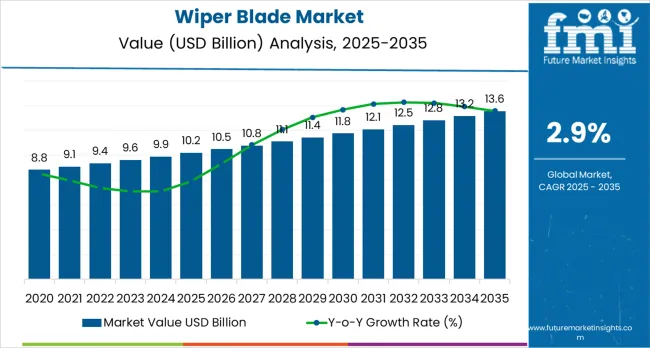
The overall market size is expected to grow by nearly 1.3 times during the same period, supported by increasing global vehicle production and ownership rates worldwide, driving demand for both OEM installation and aftermarket replacement solutions and increasing investments in advanced wiper blade technologies with enhanced durability and weather-resistant features globally.
Between 2025 and 2030, the wiper blade market is projected to expand from USD 10.22 billion to USD 11.77 billion, resulting in a value increase of USD 1.55 billion, which represents 45.7% of the total forecast growth for the decade. This phase of development will be shaped by rising demand for advanced visibility solutions in passenger and commercial vehicles, product innovation in aerodynamic blade designs and silicone-coated technologies, as well as expanding integration with smart vehicle systems and rain-sensing technologies.
Companies are establishing competitive positions through investment in advanced rubber formulations, high-performance blade technologies, and strategic market expansion across aftermarket distribution channels, e-commerce platforms, and OEM partnerships.
From 2030 to 2035, the market is forecast to grow from USD 11.77 billion to USD 13.61 billion, adding another USD 1.84 billion, which constitutes 54.3% of the overall ten-year expansion. This period is expected to be characterized by the expansion of specialized smart wiper systems, including rain-sensing platforms and heated blade solutions tailored for specific climate applications, strategic collaborations between blade manufacturers and automotive companies, and an enhanced focus on sustainability and eco-friendly production methods.
The growing emphasis on enhanced vehicle safety standards and integration with advanced driver assistance systems will drive demand for comprehensive wiper blade solutions across diverse automotive applications.
| Metric | Value |
|---|---|
| Market Value (2025) | USD 10.22 billion |
| Market Forecast Value (2035) | USD 13.61 billion |
| Forecast CAGR (2025-2035) | 2.9% |
The wiper blade market grows by enabling vehicle owners, fleet operators, and automotive service providers to optimize visibility and safety performance while accessing advanced wiper technologies without substantial recurring maintenance requirements.
Automotive consumers and service providers face mounting pressure to maintain visibility compliance and ensure driver safety, with modern wiper blades typically providing 30-40% longer service life compared to traditional alternatives, making advanced blade systems essential for vehicle safety positioning.
The automotive industry's need for reliable all-weather visibility and application-specific performance creates demand for comprehensive wiper solutions that can provide superior clearing efficiency, maintain consistent performance, and ensure safe operation without compromising visibility standards or quality requirements.
Government initiatives promoting road safety regulations and vehicle inspection standards drive adoption in passenger cars, light commercial vehicles, and heavy commercial vehicle applications, where visibility performance has a direct impact on driver safety and accident prevention.
The market is segmented by blade type, application, vehicle type, sales channel, and region. By blade type, the market is divided into flat blade systems, conventional blade systems, and hybrid blade systems. Based on the application, the market is categorized into windshield wipers and rear wipers.
By vehicle type, the market encompasses passenger cars, light commercial vehicles, and heavy commercial vehicles. Sales channel segmentation includes aftermarket and original equipment manufacturer (OEM). Regionally, the market is divided into Asia Pacific, Europe, North America, Latin America, and Middle East &Africa.
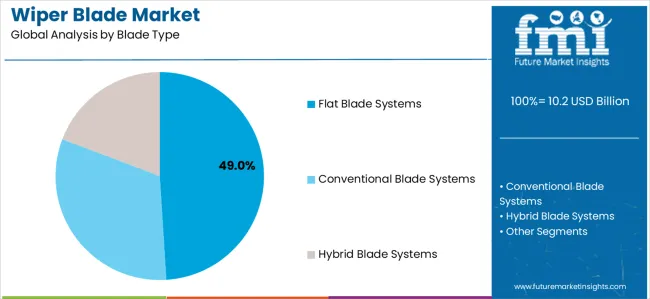
The flat blade systems segment represents the dominant force in the wiper blade market, capturing approximately 49.0% of total market share in 2025. This established technology category encompasses systems featuring sophisticated aerodynamic designs and frameless construction technologies, including advanced spring steel structures and rubber compounds that enable superior windshield contact and enhanced weather resistance across all driving conditions.
The flat blade systems segment's market leadership stems from its superior performance capabilities, with systems capable of handling diverse weather applications while maintaining consistent wiping standards and operational reliability across all automotive environments.
The conventional blade systems segment maintains a substantial 30.0% market share, serving customers who require traditional frame-based wipers with external metal structures and articulated pressure points for standard windshield applications. These systems offer cost-effective visibility solutions for budget-conscious consumers while providing sufficient wiping performance to meet regional safety standards and compliance demands.
The hybrid blade systems segment, combining features of both flat and conventional technologies, accounts for approximately 21.0% of the market, serving applications requiring enhanced performance with improved aerodynamic features or specialized weather resistance parameters.
Key technological advantages driving the flat blade systems segment include:
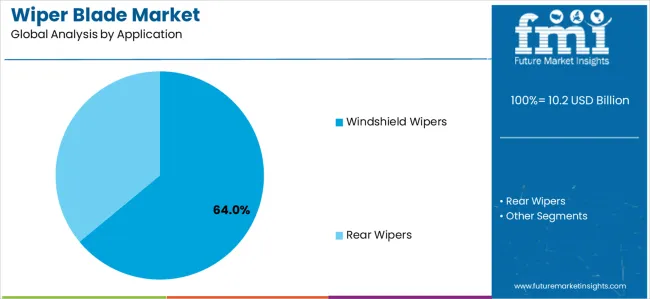
Windshield wiper applications dominate the wiper blade market with approximately 64.0% market share in 2025, reflecting the critical role of front visibility systems in supporting global vehicle operation and safety regulation compliance worldwide. The windshield wiper segment's market leadership is reinforced by increasing vehicle production trends, mandatory safety regulations, and rising requirements for enhanced visibility performance in adverse weather conditions across developed and emerging markets.
The rear wiper segment represents the second-largest application category, capturing 36.0% market share through specialized visibility requirements for SUVs, hatchbacks, station wagons, and crossover vehicle applications. This segment benefits from growing adoption of rear wiper systems beyond traditional SUV applications that meet specific visibility requirements, safety standards, and convenience expectations in competitive automotive environments.
Key market dynamics supporting application growth include:
The market is driven by three concrete demand factors tied to vehicle safety outcomes. First, global vehicle production and ownership growth create increasing demand for wiper blade products, with automotive sales expanding by 3-5% annually in major developing countries worldwide, requiring comprehensive wiper blade infrastructure. Second, government initiatives promoting vehicle safety standards and mandatory inspection requirements drive increased adoption of quality wiper systems, with many regions implementing enhanced visibility testing protocols for vehicle registration compliance by 2030. Third, technological advancements in blade materials and aerodynamic designs enable more durable and cost-effective visibility solutions that reduce replacement frequency while improving weather performance and driver safety capabilities.
Market restraints include high consumer price sensitivity for aftermarket products that can deter budget-conscious buyers from purchasing premium wiper blade technologies, particularly in developing regions where low-cost alternatives remain attractive despite inferior performance characteristics. Counterfeit product competition and quality inconsistencies pose another significant challenge, as unauthorized manufacturers produce substandard imitations that undermine brand reputation and compromise safety, potentially causing increased liability concerns and market fragmentation. Raw material cost volatility and supply chain disruptions across different regions create additional operational challenges for blade manufacturers, demanding ongoing investment in sourcing strategies and inventory management.
Key trends indicate accelerated adoption in Asia-Pacific markets, particularly China and India, where rapid vehicle production expansion and rising consumer safety awareness drive comprehensive wiper blade market adoption. Technology integration trends toward smart wiper systems with rain-sensing capabilities, heated blade elements for winter performance, and connected vehicle integration enable proactive replacement approaches that reduce maintenance costs and minimize visibility-related accidents.
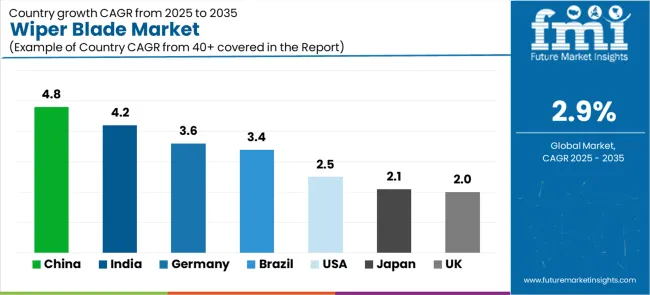
| Country | CAGR (2025-2035) |
|---|---|
| China | 4.8% |
| India | 4.2% |
| Germany | 3.6% |
| USA | 2.5% |
| Japan | 2.1% |
| UK | 2.3% |
| Brazil | 3.4% |
The wiper blade market is gaining momentum worldwide, with China taking the lead thanks to massive automotive production expansion and government-backed vehicle safety initiatives. Close behind, India benefits from expanding vehicle ownership and growing aftermarket infrastructure, positioning itself as a strategic growth hub in the Asia-Pacific region.
Germany shows steady advancement, where integration of advanced wiper technologies strengthens its role in the European automotive supply chain. Brazil is focusing on automotive market recovery and aftermarket development, signaling an ambition to capitalize on the growing opportunities in South American markets.
Meanwhile, the USA stands out for its mature aftermarket distribution networks and strong replacement demand, and the UK and Japan continue to record consistent progress in quality-focused blade adoption. Together, China and India anchor the global expansion story, while the rest build stability and diversity into the market's growth path.
The report covers an in-depth analysis of 40+ countries, Top-performing countries are highlighted below.
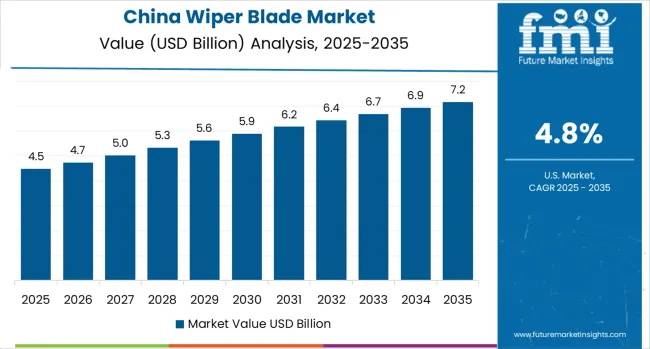
China demonstrates the strongest growth potential in the Wiper Blade Market with a CAGR of 4.8% through 2035. The country's leadership position stems from massive automotive manufacturing capacity, expanding vehicle ownership across urban and rural markets, and stringent safety regulations driving the adoption of quality wiper blade solutions.
Growth is concentrated in major automotive centers, including Beijing, Shanghai, Guangzhou, and Chongqing, where vehicle production facilities and aftermarket distribution networks are implementing advanced wiper blade solutions for enhanced safety performance and consumer satisfaction.
Distribution channels through automotive parts retailers, e-commerce platforms, and authorized service centers expand deployment across passenger vehicle projects and commercial fleet initiatives. The country's automotive industry development policies provide support for component quality standards, including wiper blade performance specifications.
Key market factors:
In Mumbai, New Delhi, Chennai, and Bangalore, the adoption of quality wiper blade solutions is accelerating across passenger car and commercial vehicle segments, driven by rapid motorization and government road safety programs. The market demonstrates strong growth momentum with a CAGR of 4.2% through 2035, linked to comprehensive automotive market development and increasing focus on vehicle maintenance awareness.
Indian consumers are implementing quality wiper blade systems and aftermarket solutions to enhance vehicle safety while meeting growing demand in expanding urban mobility and commercial transportation sectors. The country's Make in India and automotive manufacturing initiatives create sustained demand for wiper blade solutions, while increasing emphasis on monsoon season visibility drives adoption of advanced all-weather control systems.
Germany's automotive sector demonstrates sophisticated implementation of wiper blade technologies, with documented case studies showing 45% adoption of premium blade systems through quality-focused consumer preferences and integrated OEM partnerships. The country's automotive infrastructure in major manufacturing centers, including Munich, Stuttgart, Berlin, and Hamburg, showcases integration of advanced wiper technologies with vehicle systems, leveraging expertise in precision manufacturing and automotive innovation.
German manufacturers emphasize quality and durability standards, creating demand for high-performance wiper blade solutions that support extended replacement intervals and superior weather performance requirements. The market maintains steady growth through focus on technology integration and premium product positioning, with a CAGR of 3.6% through 2035.
Key development areas:
Brazil's market expansion is driven by diverse automotive demand, including passenger car growth in São Paulo and commercial vehicle applications in other major cities, and comprehensive aftermarket development across multiple states.
The country demonstrates promising growth potential with a CAGR of 3.4% through 2035, supported by federal government automotive investment programs and state-level manufacturing development initiatives. Brazilian consumers face implementation challenges related to import tariffs and economic volatility, requiring localized production approaches and support from international suppliers.
Market characteristics:
The U.S. market leads in aftermarket distribution sophistication based on integration with extensive retail networks and e-commerce platforms for enhanced consumer accessibility. The country shows steady potential with a CAGR of 2.5% through 2035, driven by the large existing vehicle fleet and comprehensive replacement cycles of aging vehicles in major automotive markets, including California, Texas, Florida, and New York.
American consumers are adopting premium wiper blade systems for visibility improvement and convenience enhancement, particularly in regions with challenging weather requirements and demanding performance applications requiring comprehensive blade upgrades. Distribution channels through automotive retailers, national chains, and online platforms expand coverage across aftermarket facilities and professional installer operators.
Leading market segments:
In London, Manchester, Birmingham, and Glasgow, vehicle owners are implementing quality wiper blade solutions to maintain MOT compliance and visibility standards, with documented consumer surveys showing a 35% preference for branded products over generic alternatives through quality awareness programs.
The market shows moderate growth potential with a CAGR of 2.3% through 2035, linked to the mature vehicle market, established maintenance culture, and mandatory inspection standards requiring functional wiper systems.
British consumers are adopting advanced wiper blade and premium solutions to enhance driving safety while maintaining regulatory standards demanded by the automotive inspection authorities. The country's established automotive infrastructure creates sustained demand for replacement solutions that integrate with modern vehicle safety systems.
Market development factors:
Japan's Wiper Blade Market demonstrates sophisticated implementation focused on quality manufacturing and performance optimization, with documented integration of advanced blade systems, achieving 45% adoption of premium technologies across passenger car and luxury vehicle segments.
The country maintains steady growth momentum with a CAGR of 2.1% through 2035, driven by automotive manufacturers'emphasis on integrated quality solutions and continuous improvement methodologies that align with vehicle safety principles applied to visibility control operations.
Major metropolitan areas, including Tokyo, Osaka, Nagoya, and Fukuoka, showcase advanced deployment of quality wiper blade platforms where systems integrate seamlessly with vehicle electronics and comprehensive maintenance programs.
Key market characteristics:
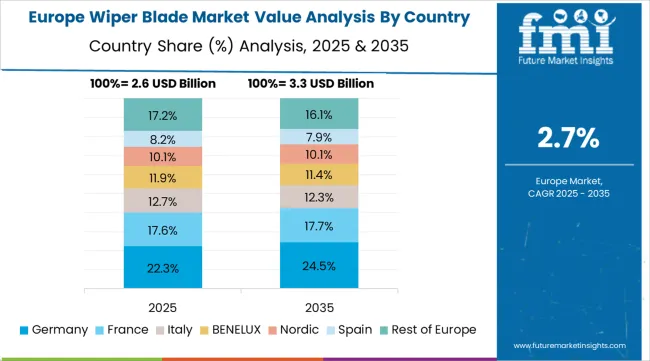
The wiper blade market in Europe is projected to grow from USD 2.87 billion in 2025 to USD 3.75 billion by 2035, registering a CAGR of 2.7% over the forecast period. Germany is expected to maintain its leadership position with a 32.4% market share in 2025, declining slightly to 32.1% by 2035, supported by its extensive automotive manufacturing infrastructure, premium vehicle brands, and comprehensive aftermarket distribution networks serving major European markets.
The United Kingdom follows with a 19.2% share in 2025, projected to reach 19.5% by 2035, driven by comprehensive vehicle inspection programs in London, Manchester, and other industrial areas implementing quality wiper blade systems. France holds a 17.3% share in 2025, expected to maintain 16.9% by 2035 through the ongoing development of aftermarket retail networks and OEM partnerships.
Italy commands a 13.6% share, while Spain accounts for 9.8% in 2025. The Rest of Europe region is anticipated to gain momentum, expanding its collective share from 7.7% to 8.2% by 2035, attributed to increasing wiper blade adoption in Nordic countries and emerging Eastern European automotive markets implementing safety programs.
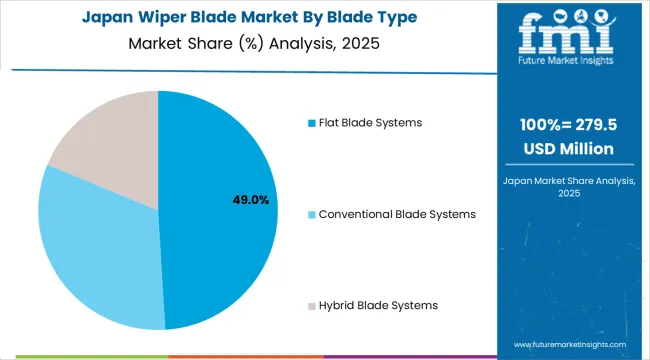
The Japanese Wiper Blade Market demonstrates a mature and quality-focused landscape, characterized by sophisticated integration of flat blade systems with existing vehicle infrastructure across passenger cars, premium vehicles, and commercial applications. Japan's emphasis on manufacturing excellence and quality standards drives demand for high-reliability wiper solutions that support continuous improvement initiatives and stringent performance requirements in automotive operations.
The market benefits from strong partnerships between international blade providers like Robert Bosch GmbH, DENSO Corporation, and domestic technology leaders, including Mitsuba Corporation, creating comprehensive service ecosystems that prioritize system quality and consumer education programs.
Automotive centers in Tokyo, Osaka, Nagoya, and other major industrial areas showcase advanced quality implementations where wiper blade systems achieve superior performance through integrated quality monitoring programs.
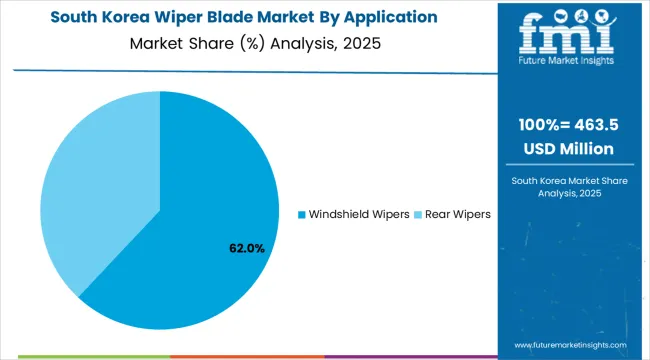
The South Korean Wiper Blade Market is characterized by strong international technology provider presence, with companies like Robert Bosch GmbH, Valeo SA, and DENSO Corporation maintaining dominant positions through comprehensive distribution networks and technical expertise for passenger vehicle and commercial vehicle applications.
The market is demonstrating a growing emphasis on localized distribution support and rapid delivery capabilities, as Korean consumers increasingly demand convenient purchasing options that integrate with domestic automotive retail infrastructure and e-commerce platforms deployed across the Seoul Metropolitan Area and other major technology cities. Local automotive parts retailers and regional distributors are gaining market share through strategic partnerships with global providers, offering specialized services including installation support programs and warranty services for wiper blade products.
The competitive landscape shows increasing collaboration between multinational blade companies and Korean retail specialists, creating hybrid distribution models that combine international product quality with local market knowledge and customer relationship management.
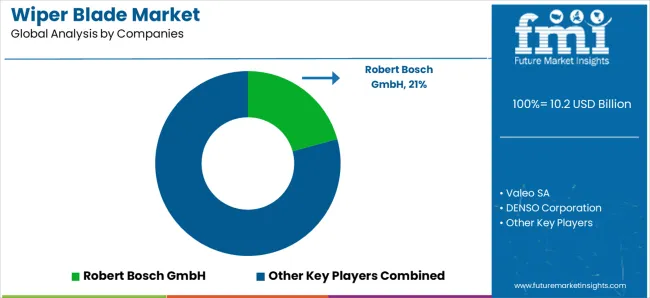
The Wiper Blade Market features approximately 50-60 meaningful players with moderate concentration, where the top three companies control roughly 40-45% of global market share through established product portfolios and extensive automotive industry relationships. Competition centers on product quality, brand reputation, and distribution reach rather than price competition alone.
Market leaders include Robert Bosch GmbH, Valeo SA, and DENSO Corporation, which maintain competitive advantages through comprehensive wiper blade solution portfolios, global distribution networks, and deep expertise in the automotive OEM and aftermarket sectors, creating high brand loyalty for customers. These companies leverage established technical relationships and ongoing innovation programs to defend market positions while expanding into emerging markets and premium product applications.
Challengers encompass Trico Products Corporation and Federal-Mogul Motorparts LLC, which compete through specialized blade solutions and strong regional presence in key automotive markets. Technology specialists, including HELLA GmbH &Co. KGaA, Mitsuba Corporation, and Continental AG, focus on specific blade technologies or vertical applications, offering differentiated capabilities in premium blades, smart wiper systems, and application-specific solutions.
Regional players and emerging blade manufacturers create competitive pressure through cost-effective solutions and rapid distribution capabilities, particularly in high-growth markets including China and India, where local presence provides advantages in consumer access and regulatory compliance. Market dynamics favor companies that combine advanced blade technologies with comprehensive distribution networks that address the complete product lifecycle from manufacturing through consumer purchase and installation support.
Wiper blade solutions represent a critical automotive safety technology that enables vehicle owners, fleet operators, and automotive service providers to maintain optimal visibility and driving safety without substantial maintenance intervention requirements, typically providing 30-40% longer service life and superior performance compared to conventional alternatives.
With the market projected to grow from USD 10.22 billion in 2025 to USD 13.61 billion by 2035 at a 2.9% CAGR, these solutions offer compelling advantages including superior visibility, enhanced durability, and advanced weather resistance making them essential for passenger cars (60% market share), light commercial vehicles (20% share), and diverse heavy commercial vehicle applications seeking reliable visibility solutions.
Scaling market penetration and technology capabilities requires coordinated action across automotive policy, industry standards, blade manufacturers, distribution networks, and consumer education institutions.
| Item | Value |
|---|---|
| Quantitative Units | USD 10.22 Billion |
| Blade Type | Flat Blade Systems, Conventional Blade Systems, Hybrid Blade Systems |
| Application | Windshield Wipers, Rear Wipers |
| Vehicle Type | Passenger Cars, Light Commercial Vehicles, Heavy Commercial Vehicles |
| Sales Channel | Aftermarket, Original Equipment Manufacturer (OEM) |
| Regions Covered | Asia Pacific, Europe, North America, Latin America, Middle East &Africa |
| Country Covered | China, India, Germany, Brazil, the U.S., the U.K., Japan, and 40+ countries |
| Key Companies Profiled | Robert Bosch GmbH, Valeo SA, DENSO Corporation, Trico Products Corporation, HELLA GmbH &Co. KGaA, Federal-Mogul Motorparts LLC, Mitsuba Corporation, PIAA Corporation, Continental AG, Magneti Marelli S.p.A., Nippon Wiper Blade Co. Ltd., Goodyear Tire &Rubber Company, DOGA S.A., WEXCO Industries Inc., Michelin Lifestyle Limited |
| Additional Attributes | Dollar sales by blade type, application, vehicle type, and sales channel categories, regional adoption trends across Asia Pacific, Europe, and North America, competitive landscape with blade manufacturers and distribution networks, automotive aftermarket requirements and specifications, integration with vehicle safety systems and advanced driver assistance platforms, innovations in blade materials and aerodynamic technologies, and development of specialized applications with weather resistance and durability capabilities. |
The global wiper blade market is estimated to be valued at USD 10.2 billion in 2025.
The market size for the wiper blade market is projected to reach USD 13.6 billion by 2035.
The wiper blade market is expected to grow at a 2.9% CAGR between 2025 and 2035.
The key product types in wiper blade market are flat blade systems, conventional blade systems and hybrid blade systems.
In terms of application, windshield wipers segment to command 64.0% share in the wiper blade market in 2025.






Full Research Suite comprises of:
Market outlook & trends analysis
Interviews & case studies
Strategic recommendations
Vendor profiles & capabilities analysis
5-year forecasts
8 regions and 60+ country-level data splits
Market segment data splits
12 months of continuous data updates
DELIVERED AS:
PDF EXCEL ONLINE
APAC Wiper Blade Industry Size and Share Forecast Outlook 2025 to 2035
Automotive Wiper Blade Market Growth – Trends & Forecast 2024 to 2034
Automotive Wiper Motor Market Size and Share Forecast Outlook 2025 to 2035
Bathroom Mirror Wiper Market Size and Share Forecast Outlook 2025 to 2035
Blade Server Market Size and Share Forecast Outlook 2025 to 2035
Saw Blades Market Size, Share, and Forecast 2025 to 2035
Air Blade Dryer Market Size, Share, and Forecast 2025 to 2035
Grader Blades Market Size and Share Forecast Outlook 2025 to 2035
Hacksaw Blades Market Size and Share Forecast Outlook 2025 to 2035
Turbine Blade Material Market Size and Share Forecast Outlook 2025 to 2035
Competitive Breakdown of Razor and Blade Providers
Razor and Blade Market Insights – Growth & Forecast 2024-2034
Helicopter Blades Market Size and Share Forecast Outlook 2025 to 2035
Skin Graft Blades Market
Wind Turbine Blade Market Size and Share Forecast Outlook 2025 to 2035
Circular Saw Blade Market Growth – Trends & Forecast 2024-2034
Wind Turbine Blade Repair Material Market Growth – Trends & Forecast 2024-2034
Aircraft Engine Blade Market Size and Share Forecast Outlook 2025 to 2035
Stone Cutting Saw Blades Market Analysis & Forecast by Blade Type, Blade Diameter, End User, and Region Forecast Through 2035
Offshore Wind Turbine Blade Market Size and Share Forecast Outlook 2025 to 2035

Thank you!
You will receive an email from our Business Development Manager. Please be sure to check your SPAM/JUNK folder too.
Chat With
MaRIA